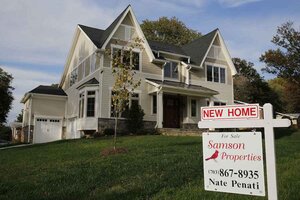New homes sales hold steady despite winter swoon in the Northeast
New home sales in the US fell 0.2 percent in January to a 481,000 annual pace, according to the Commerce Department. Even with the drop, it was the best January for new home sales since 2008, and the pace of sales remained near post-recession highs.

A real estate sign advertising a new home for sale is pictured in Vienna, Va. New US single-family home sales in January fell less than expected and supply rose to its highest level since 2010, hopeful signs for the sluggish housing market.
Larry Downing/Reuters/File
January has been a month full of negative housing data, but today’s, at least, was relatively good news.
Sales of new homes dipped a slight 0.2 percent to a 481,000 annualized pace in January, according to data released Wednesday by the Commerce Department. Economists had expected a bigger decline, to about a 470,000 pace. Even with the drop, it was the best January for new home sales since 2008, and the pace of sales remained near post-recession highs.
Sales varied drastically from region to region: While the South saw a 2.2 percent increase, sales in the winter-battered Northeast plunged 51.6 percent last month, hitting a low 15,0000 annual rate. Figures for November and December were also revised upward, to yearly paces of 446,000 and 482,000, respectively.
New home sales only make up about 7 percent of the overall residential market. So January’s report is an admittedly thin ray of sunlight for housing, which has had a gray, gloomy start to 2015. Earlier this week, a report of sales of existing home sales, a much larger indicator, showed a 4.9 percent January drop, and new construction has stalled early in the year. Meanwhile, growth in home prices continues to speed along – normally a good sign, but worrying when they outpace wage growth and price out first-time buyers.
Today’s data continued that last trend, with the median sales price of a new home increasing 9.1 percent year-over-year to $294,300. “The high end market is improving; the low end is not,” IHS Global Insight economists Stephanie Karol and Patrick Newport write in an e-mailed analysis. “Sales of high end homes – over $500,000 – increased in 2014, while sales of low end homes – under $200,000 – fell…Builders are catering to a wealthier client, who wants a large new house inside a metropolitan statistical area, even if it means building on a smaller lot.”
Still, the supply of available new homes increased to their highest level since 2010, a hopeful sign that increased purchases will eventually follow. For that, analysts are looking ahead to the typically busy spring selling season, which should paint a clearer picture of the market’s overall health. In the meantime, another area of the housing industry – renovations – is thriving as homes available for sale grow scarce and owners opt to stay in their houses longer.
On Tuesday, Home Depot, the nation’s largest home-improvement retailer, reported a blockbuster fourth quarter of 2014. The company saw a 36 percent rise in profits and had its biggest sales day ever on Black Friday of last year. Shoppers spent $500 million in Home Depot stores the day after Thanksgiving, according to the company. Home Depot’s main competitor, Lowe’s, also posted better-than-expected fourth quarter sales and profits Tuesday. The stock prices for both companies have surged over the past year.

